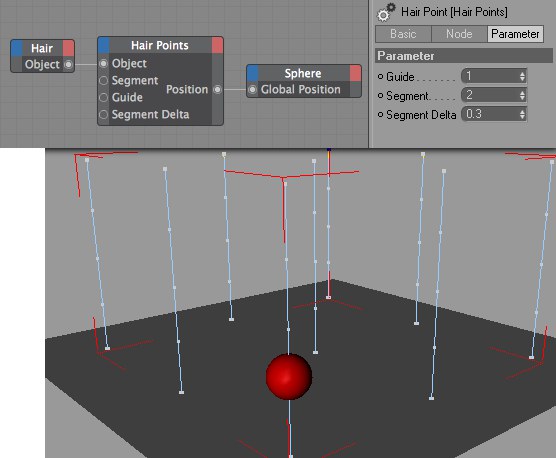 Hair Points 毛发点Basic 基础Node 节点Parameter 参数
Hair Points 毛发点Basic 基础Node 节点Parameter 参数
Parameter
参数
•物体
Links the object whose values should be set or read out.
链接值应该设置或读出的对象。
•安
A Boolean value that will turn the Node on or off.
一个布尔值,用于打开或关闭 Node。
•动态位置[ XYZ ]
This setting lets you affect the dynamic guides directly. Each guide point can be set arbitrarily.
这个设置可以让你直接影响动态导轨。每个导轨点可以任意设置。
•速度[ XYZ ]
Use this port to pass on velocity as a vector.
使用此端口将速度作为矢量传递。
• Index[-2147483648..2147483647]
索引[-2147483648. . 2147483647]
Internally each guide and hair point has a unique consecutive number, which can be addressed individually. The numbers can be used with the Index input port to, for example, to connect a Hair Selection Node that contains all points within a given selection.
在内部,每个指南和发点都有一个唯一的连续编号,可以单独处理。这些数字可以与 Index 输入端口一起使用,例如,用于连接一个包含给定选择内所有点的“毛发选择节点”。
•增加力度[ XYZ ]
This setting will pass on forces as vectors, upon which dynamics will have an influence.
这个设置将作为向量传递力量,动态将对其产生影响。
•质量[-∞ . . + ∞]
Use this port to define mass for guide points or hair points. This only makes sense if you want to stop the movement of individual guide points or hair points. Points with a mass of 0 will not be moved by dynamics. Otherwise, mass will have no influence on dynamics.
使用此端口为导向点或发尖定义质量。这只有在你想要停止个人引导点或发点的运动时才有意义。质量为0的点不会被动力学移动。否则,质量将不会对动力学产生影响。
•定位[ XYZ ]
Use this port to pass the position on each guide or hair as a vector.
使用此端口将每个指南或毛发上的位置作为矢量传递。
•
Segment[-2147483648..2147483647]
•
Guide[-2147483648..2147483647]
•
Segment Delta[-∞..+∞]
•片段[-2147483648. . 2147483647]•指南[-2147483648. . 2147483647]•片段 Delta [-∞ . + ∞]
Use these three input ports define exact positions on guides or hairs:
使用这三个输入端口定义导轨或毛发的精确位置:
 Guides, segments, and each individual guide point
are numbered. 导轨、片段和每个单独的导轨点都有编号
Guides, segments, and each individual guide point
are numbered. 导轨、片段和每个单独的导轨点都有编号
The image above shows examples of consecutively numbered segments. All positions between guide points can be accessed using Segment Delta, and the index numbers, e.g., within the (Hair) Selection Tag, will be used to read out the selections contained in the tag.
上面的图片显示了连续编号段的例子。导航点之间的所有位置都可以使用 Segment Delta 进行访问,并且索引号(例如,在(Hair) Selection Tag 中)将用于读出标记中包含的选择。

Using a setup as shown above, objects or object points can be placed precisely on guide or hair positions.
使用如上所示的设置,物体或物体点可以精确地放置在导游或毛发的位置。
Even though 尽管如此Segment Delta 部分三角洲 lets you address positions between guide and hair points, forces will (internally) only be passed on to the points themselves. The following applies to defined 让您地址之间的引导点和毛发点的立场,力量将(内部)只传递到点本身。以下内容适用于已定义的Segment Deltas 三角洲部分: A value between : 介于0 and 及0.5 will result in the segment starting point being used; a value between 将导致段的起始点被使用;0.5 and 及1 will result in the segment end point being used. 将导致段终点被使用位置[ XYZ ]•
This port contains the exact positions in space, as defined by Object, Guide, Segment and Segment Delta, in vector form.
此端口包含空间中的精确位置,由 Object、 Guide、 Segment 和 Segment Delta 以矢量形式定义。
切线[ XYZ ]•
This port outputs the guide and hair tangents as vectors.
这个端口输出指南和毛发切线作为向量。
速度[ XYZ ]•
Use this port to output the velocity of any point approaching a guide.
使用此端口输出任何接近指南点的速度。
质量[-∞ . . + ∞]•
Use this port to output the mass. The mass will generally be varied along the length of the entire guide (1). Mass can also be varied according to point, using the Hair object’s Dynamics tab.
使用这个端口输出质量。质量通常沿着整个导轨(1)的长度变化。质量也可以根据点变化,使用毛发对象的动态标签。
力量[ XYZ ]•
Use this port to pass a force on to an input port. This force will be added internally to the dynamics forces, the sum of which will then be output.
使用此端口向输入端口传递一个力。这个力将被内部加到动力中,动力的总和就是输出。